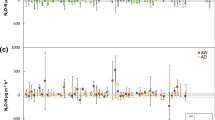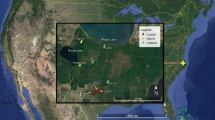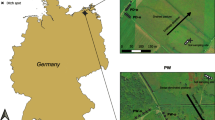Abstract
The aim of the study was to document methane (CH4) dynamics from fen ecosystems in the Athabasca Oil Sands Region (AOSR) in northern Alberta to create a reference database for evaluation of peatland restoration and reclamation projects in the region. The study included three types of fens commonly occurring in this region: poor fen (open and treed), moderately-rich treed fen, and open saline fen (SF). We quantified CH4 fluxes, pore water concentration (PW[CH4]), and production potential together with ecohydrological variables that may influence CH4 dynamics over four growing seasons. Mean (standard deviation) fluxes for open and treed poor fen [99.8 (269.7) and 68.3 (118.8) mg CH4 m−2 day−1, respectively] were higher than for treed rich [32.8 (63.7) mg CH4 m−2 day−1] and open SFs [34.6 (91.3) mg CH4 m−2 day−1]. The total growing season CH4 emissions from these fens ranged between 3.7 and 11.3 g CH4 m−2. Methane production potential varied from 0.1 (0.1) µmol CH4 g peat−1 day−1 at the SF to 4.6 (0.8) µmol CH4 g peat−1 day−1 at the treed rich fen. The variability of CH4 fluxes and pore water concentration between study sites and years was mostly controlled water table (WT) and soil temperature indicating that these variables should be used to assess the expected CH4 flux in peatland reclamation projects. Large inter-annual variability in CH4 flux illustrates the importance of multi-year records for data used in functional evaluation of restoration outcomes.





Similar content being viewed by others
Data availability
All data is available from the corresponding author by request.
References
Abdalla M, Hastings A, Truu J, Espenberg M, Mander Ü, Smith P (2016) Emissions of methane from northern peatlands: a review of management impacts and implications for future management options. Ecol Evol 6:7080–7102
Andersen R, Chapman SJ, Artz R (2013) Microbial communities in natural and disturbed peatlands: a review. Soil Biol Biochem 57:979–994
Auguie B (2016) gridExtra: miscellaneous functions for “Grid” Graphics. R package version 2.2.1. https://CRAN.R-project.org/package=gridExtra
Barton K (2016) MuMIn: multi-model inference. R package version 1.15.6. https://CRAN.R-project.org/package=MuMIn
Bellisario LM, Bubier JL, Moore TR, Chanton JP (1999) Controls on CH4 emissions from a northern peatland. Glob Biogeochem Cycles 13:81–91
Bhullar GS, Edwards PJ, Venterink HO (2013) Variation in plant-mediated methane transport and its importance for methane emission from intact wetland peat mesocosms. J Plant Ecol 6:298–304
Blodau C (2002) Carbon cycling in peatlands—a review of processes and controls. Environ Rev 10:111–134
Bocking E, Cooper DJ, Price J (2017) Using tree ring analysis to determine impacts of a road on a boreal peatland. For Ecol Manag 404:24–30
Bridgham SD, Cadillo-Quiroz H, Keller JK, Zhuang Q (2013) Methane emissions from wetlands: biogeochemical, microbial, and modeling perspectives from local to global scales. Glob Change Biol 19:1325–1346
Chasar LS, Chanton JP, Glaser PH, Siegel DI (2000) Methane concentration and stable isotope distribution as evidence of rhizospheric processes: comparison of a fen and bog in the Glacial Lake Agassiz Peatland Complex. Ann Bot 86:655–663
Clark MG, Humphrey ER, Carey SK (2019) Low methane emissions from a boreal wetland constructed on oil sand mine tailings. Biogeosci Discuss. https://doi.org/10.5194/bg-2019-271
Clymo RS, Bryant C (2008) Diffusion and mass flow of dissolved carbon dioxide, methane, and dissolved organic carbon in a 7-m deep raised peat bog. Geochim Cosmochim Acta 72:2048–2066
Couwenberg J, Fritz C (2012) Towards developing IPCC methane ‘emission factors’ for peatlands (organic soils). Mires Peat 10:03
Daly C, Price J, Rezanezhad F, Pouliot R, Rochefort L, Graf MD (2012) Initiatives in oil sand reclamation: considerations for building a fen peatland in post mined oil sands landscape. In: Vitt DH, Bhatti J (eds) Restoration and reclamation of boreal ecosystems. Cambridge University Press, New York
Elmes MC, Thompson DK, Sherwood JH, Price JS (2018) Hydrometeorological conditions preceding wildfire, and the subsequent burning of a fen watershed in Fort McMurray, Alberta, Canada. Nat Hazards Earth Syst Sci 18:157–170
Environment and Climate Change Canada (2018) Historical climate data. https://climate.weather.gc.ca/. Accessed 19 July 2018
Environment and Parks (2017) Reclamation criteria for wellsites and associated facilities for peatlands, March 2017. Environment and Parks, Edmonton, p 142
Estop-Aragonés C, Knorr K-H, Blodau C (2013) Belowground in situ redox dynamics and methanogenesis recovery in a degraded fen during dry–wet cycles and flooding. Biogeosciences 10:421–436
Gauci V, Gowing DJG, Hornibrook ERC, Davis JM, Dise NB (2010) Woody stem methane emission in mature wetland alder trees. Atmos Environ 44:2157–2160
Glaser PH, Chanton JP, Morin P, Rosenberry DO, Siegel DI, Ruud O, Chasar LI, Reeve AS (2004) Surface deformations as indicators of deep ebullition fluxes in a large northern peatland. Glob Biogeochem Cycles 18:GB1003
Godin A, McLaughlin JW, Webster KL, Packalen M, Basiliko N (2012) Methane and methanogen community dynamics across a boreal peatland nutrient gradient. Soil Biol Biochem 48:96–105
Gorham E, Rochefort L (2003) Peatland restoration: a brief assessment with special reference to Sphagnum bogs. Wetl Ecol Manag 11:109–119
Government of Alberta (2018) https://www.energy.alberta.ca/OS/AOS/Pages/FAS.aspx#Environment. Accessed 19 July 2018
Gupta V, Smemo KA, Yavitt JB, Fowle D, Branfireun B, Basiliko N (2013) Stable isotopes reveal widespread anaerobic methane oxidation across latitude and peatland type. Environ Sci Technol 47:8273–8279
Kampbell DH, Vandegrift SA (1998) Analysis of dissolved methane, ethane, and ethylene in ground water by a standard gas chromatographic technique. J Chromatogr Sci 36:253–256
Kip N, van Winden JF, Pan Y, Bodrossy L, Reichart G, Smolders AJP, Jetten MSM, Damste JSS, Op den Camp HJM (2010) Global prevalence of methane oxidation by symbiotic bacteria in peat-moss ecosystems. Nat Geosci 3:617–621
Lai D (2009) Methane dynamics in northern peatlands: a review. Pedosphere 19:409–421
Lenth RV (2016) Least-squares means: the R package lsmeans. J Stat Softw 69:1–33
Liblik LK, Moore TR, Bubier JL, Robinson SD (1997) Methane emissions from wetlands in the zone of discontinuous permafrost: Fort Simpson, Northwest Territories, Canada. Glob Biogeochem Cycles 11:485–494
Linderholm HW (2006) Growing season changes in the last century. Agric For Meteorol 137:1–14
Long KD, Flanagan LB, Tiebo C (2010) Diurnal and seasonal variation in methane emissions in a northern Canadian peatland measured by eddy covariance. Glob Change Biol 16:2420–2435
Madigan MT (2009) Brock biology of microorganisms, 12th edn. Pearson/Benjamin Cummings, San Francisco
Malhotra A (2010) Carbon cycling, Sphagnum primary production and hydrology of a poor fen in Alberta, Canada. M.Sc. Thesis, Villanova University, Villanova, PA
Minderlein S, Blodau C (2010) Humic-rich peat extracts inhibit sulfate reduction, methanogenesis, and anaerobic respiration but not acetogenesis in peat soils of a temperate bog. Soil Biol Biochem 42:2078–2086
Munir TM, Perkins M, Kaing E, Strack M (2015) Carbon dioxide flux and net primary production of a boreal treed bog: responses to warming and water-table-lowering simulations of climate change. Biogeosciences 12:1091–1111
Murdoch D (2017) Tables: formula-driven table generation. R package version 0.8.3. https://CRAN.R-project.org/package=tables
Murray KR, Barlow N, Strack M (2017a) Methane emissions dynamics from a constructed fen and reference sites in the Athabasca Oil Sands Region, Alberta. Sci Total Environ 583:369–381
Murray KR, Borkenhagen AK, Cooper DJ, Strack M (2017b) Growing season carbon gas exchange from peatlands used as a source of vegetation donor material for restoration. Wetl Ecol Manag 25:501–515
Nwaishi F, Petrone R, Price J, Andersen R (2015) Towards developing a functional-based approach for constructed peatlands evaluation in the Alberta oil sands region, Canada. Wetlands 35:211–225
Pangala SR, Moore S, Hornibrook ERC, Gauci V (2013) Trees are major conduits for methane egress from tropical forested wetlands. N Phytol 197:524–531
Parmentier FJW, van Huissteden J, Kip N, Op den Camp HJM, Jetten MSM, Maximov TC, Dolman AJ (2011) The role of endophytic methane-oxidizing bacteria in submerged Sphagnum in determining methane emissions of Northeastern Siberian tundra. Biogeosciences 8:1267–1278
Pelletier L, Moore TR, Roulet NT, Garneau M, Beaulieu-Audy V (2007) Methane fluxes from three peatlands in the la Grande Rivière Watershed, James Bay Lowland, Canada. J Geophys Res 112:1–12
Pinheiro J, Bates D, DebRoy S, Sarkar D, R Core Team (2017) nlme: linear and nonlinear mixed effects models. R package version 3.1-131. https://CRAN.R-project.org/package=nlme
Popp TJ, Chanton JP, Whiting GJ, Grant N (2000) Evaluation of methane oxidation in the rhizosphere of a Carex dominated fen in north central Alberta, Canada. Biogeochemistry 51:259–281
Province of Alberta (2018) Environmental Protection and Enhancement Act, Conservation and Reclamation Regulation. Alberta Queen’s Printer, Edmonton
R Core Team (2017) R: a language and environment for statistical computing. R Foundation for Statistical Computing, Vienna. https://www.R-project.org/
Rask H, Schoenau J, Anderson D (2002) Factors influencing methane flux from a boreal forest wetland in Saskatchewan. Soil Biol Biochem 34:435–443
Rinne J, Tuittila E-S, Peltola O, Li X, Raivonen M, Alekseychik P, Haapanala S, Pihlatie M, Aurela M, Mammarella I, Vesala T (2018) Temporal variation of ecosystem scale methane emission from a boreal fen in relation to temperature, water table position, and carbon dioxide fluxes. Glob Biogeochem Cycles 32:1087–1106
Robeson SM (2002) Increasing growing-season length in Illinois during the 20th century. Clim Change 52:219–238
Rosenberry DO, Glaser PH, Siegel DI (2006) The hydrology of northern peatlands as affected by biogenic gas: current developments and research needs. Hydrol Process 20:3601–3610
Saarnio S, Morero M, Shurpali NJ, Tuittila MM, Alm J (2007) Annual CO2 and CH4 fluxes of pristine boreal mires as a background for the lifecycle analyses of peat energy. Boreal Environ Res 12:101–113
Simhayov RB, Weber TKD, Price JS (2018) Saturated and unsaturated chemical non-equilibrium salt transport in peat from a constructed fen. Soil 4:63–81
Sjörs H (1950) On the relation between vegetation and electrolytes in north Swedish mire waters. Oikos 2:241–258
Strack M, Waddington JM (2008) Spatiotemporal variability in peatland subsurface methane dynamics. J Geophys Res 113:G02010. https://doi.org/10.1029/2007JG000472
Strack M, Waddington JM, Tuittila E-S (2004) Effect of water table drawdown on northern peatland methane dynamics: implications for climate change. Glob Biogeochem Cycles 18:GB4003. https://doi.org/10.1029/2003GB002209
Strack M, Mwakanyamale K, Hassanpour Fard G, Bird M, Bérubé V, Rochefort L (2017) Effect of plant functional type on methane dynamics in a restored minerotrophic peatland. Plant Soil 410:1–16
Strack M, Softa D, Bird M, Xu B (2018) Impact of winter roads on boreal peatland carbon exchange. Glob Change Biol 24:e201–e212
Sukyer AE, Verma SB, Clement RJ, Billesbach DP (1996) Methane flux in a boreal fen: season-long measurement by eddy correlation. J Geophys Res Atmos 101:28637–28647
Sundh I, Mikkelä C, Nilsson M, Svensson BH (1995) Potential aerobic methane oxidation in a Sphagnum-dominated peatland-controlling factors and relation to methane emission. Soil Biol Biochem 27:829–837
Sutton-Grier AE, Megonigal JP (2011) Plant species traits regulate methane production in freshwater wetland soils. Soil Biol Biochem 43:413–420
Turetsky MR, Wieder RK, Vitt DH (2002) Boreal peatland C fluxes under varying permafrost regimes. Soil Biol Biochem 34:907–912
Turetsky MR, Kotowska A, Bubier J, Dise NB, Crill P, Hornibrook ERC, Minkkinen K, Moore TR, Myers-Smith I, Nykanen H, Olefeldt D, Rinne J, Saarnio S, Shurpali N, Tuitilla E-S, Waddington JM, White JR, Wickland KP, Wilmking M (2014) A synthesis of methane emissions from 71 northern, temperate, and subtropical wetlands. Glob Change Biol 20:2183–2197
Treat CC, Bubier JL, Varner RK, Crill PM (2007) Timescale dependence of environmental and plant-mediated controls on CH4 flux in a temperate fen. J Geophys Res 112:G01014. https://doi.org/10.1029/2006JG000210
Treat CC, Bloom AA, Marushchak ME (2018) Nongrowing season methane emissions—a significant component of annual emissions across northern ecosystems. Glob Change Biol 24:3331–3343
Trites M, Bayley SE (2009) Vegetation communities in continental boreal wetlands along a salinity gradient: implications for oil sands mining reclamation. Aquat Bot 91:27–39
Tuittila E, Komulainen V, Vasander H, Nykanen H, Martikainen P, Laine J (2000) Methane dynamics of a restored cut-away peatland. Glob Change Biol 6:569–581
Vitt D, Halsey L, Thormann M, Martin T (1996) Peatland inventory of Alberta. Phase 1: overview of peatland resources in the natural regions and subregions of the province. University of Alberta, Edmonton
Vitt DH, Halsey LA, Bauer IE, Campbell C (2000) Spatial and temporal trends in carbon storage of peatlands of continental western Canada through the Holocene. Can J Earth Sci 37:683–693
Waddington JM, Roulet NT, Swanson RV (1996) Water table control of CH4 emission enhancement by vascular plants in boreal peatlands. J Geophys Res 101:22775–22785
Wells CM, Price JS (2015) A hydrologic assessment of a saline-spring fen in the Athabasca Oil Sands Region, Alberta, Canada—a potential analogue for oil sands reclamation. Hydrol Process 29:4533–4548
Wells C, Ketcheson S, Price J (2017) Hydrology of a wetland-dominated headwater basin in the boreal plain, Alberta, Canada. J Hydrol 547:168–183
Whalen SC (2005) Biochemistry of methane exchange between natural wetlands and the atmosphere. Environ Eng Sci 22:73–94
Whiting GJ, Chanton JP (1993) Primary production control of methane emission for wetlands. Nature 364:794–795
Whiting GJ, Chanton JP (2001) Greenhouse gas balance of wetlands: methane emission versus carbon sequestration. Tellus 53B:521–528
Wickham H (2009) ggplot2: elegant graphics for data analysis. Springer, New York
Wilke CO (2016) cowplot: streamlined plot theme and plot annotations for ‘ggplot2’. R package version 0.7.0. https://CRAN.R-project.org/package=cowplot
Zuur AF, Ieno EN, Walker NJ, Saveliev AA, Smith GM (2009) Mixed effects models and extensions with R. Springer, New York
Acknowledgements
Funding for this project was provided by a Natural Sciences and Engineering Research Council of Canada (NSERC) Collaborative Research and Development (CRD) Grant (#418557) to JP and MS co-funded by Suncor Energy, Inc., Imperial Oil Resources Limited, and Shell Canada Energy. The authors would like to acknowledge Canada’s Oil Sands Innovation Alliance (COSIA) for its support of this project. Funders had no role in study design, data analysis or decision to publish the results. We thank Peter Macleod and Mendel Perkins for help collecting field data. Suggestions from anonymous reviewers improved the manuscript.
Author information
Authors and Affiliations
Contributions
MS, MSM and RA conceived the field study and implemented the design. JP, VD, RA and FN conceived the incubation study. VD, RA, FN, MSM and MS collected data and contributed to data analysis. AB completed final statistical analysis and wrote the first draft of the paper. All authors edited the final manuscript.
Corresponding author
Additional information
Publisher's Note
Springer Nature remains neutral with regard to jurisdictional claims in published maps and institutional affiliations.
Rights and permissions
About this article
Cite this article
Bienida, A., Daté, V., Andersen, R. et al. Methane emissions from fens in Alberta’s boreal region: reference data for functional evaluation of restoration outcomes. Wetlands Ecol Manage 28, 559–575 (2020). https://doi.org/10.1007/s11273-020-09715-2
Received:
Accepted:
Published:
Issue Date:
DOI: https://doi.org/10.1007/s11273-020-09715-2




